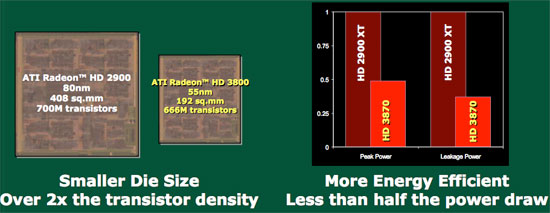ATI Radeon HD 3870 & 3850: A Return to Competition
by Anand Lal Shimpi & Derek Wilson on November 15, 2007 12:00 AM EST- Posted in
- GPUs
Finally. We're finally getting somewhere interesting in the graphics industry. Although they're sure to return, the days of reviewing $600 graphics card after $600 graphics card are on hiatus, and instead we're reviewing a new class of mainstream cards with earth-shattering performance.
NVIDIA's GeForce 8800 GT kicked off the trend, in one fell swoop making almost all of NVIDIA's product line obsolete thanks to the high performance and low price tag (we'll talk about that last part shortly). But what we saw there wasn't a fluke, it was a preemptive strike against AMD, who have been hard at work on an affordable GPU of their own.
This new product, like the 8800 GT, would be aimed squarely at the $150 - $250 market segment, something both AMD and NVIDIA did a horrible job at with mainstream releases earlier this year (2600 and 8600 both sucked guys).
Introducing the RV670
AMD's two new graphics cards launching today are both based off a new GPU, referred to internally as the RV670. The basic architecture of the hardware is largely unchanged from R600; there has been some additional functionality added, and a great deal of internal bandwidth removed, but other than that this is very much an R600 based part.

The biggest news of this part is that it is fabbed on a 55nm TSMC process. This is a half-node process based on 65nm technology, giving AMD an advantage in die size (cost) and potentially clock speed and/or power.

Historically, AMD's RV series has been a cost cut version of their R series designed for lower end volume parts, and that's where RV670 started. Right of the bat, half the external and internal memory bandwidth of R600 was cut out. External bandwidth dropped from 512-bit to 256-bit, but AMD stuck with 8 memory channels (each dropped from 64bit to 32bit).
Internally, the ring bus dropped from 1024-bit to 512-bit. This cut in bandwidth contributed to a significant drop in transistor count from R600's ~720M. RV670 is made up of 666M transistors, and this includes the addition of UVD hardware, some power saving features, the necessary additions for DX 10.1 and the normal performance tuning we would expect from another iteration of the architecture.

Processing power remains unchanged from the R600; the RV670 features 320 stream processors, 16 texture units and 16 redner back-ends. Clock speeds have gone up slightly and memory speeds have increased tremendously to make up for the narrower memory bus.
The RV670 GPU is also fully PCI Express 2.0 compliant like NVIDIA's G92, the heart and soul of the GeForce 8800 GT.










117 Comments
View All Comments
nowayout99 - Friday, November 16, 2007 - link
I don't see a noise slide...But actually, Anand, noise may be a deciding factor for me. I'd really like to know what the cards sound like vs. the GT8800, particularly the 3870, if you guys could come back to it.
starjax - Thursday, November 15, 2007 - link
What about testing with updated drivers? I understand that the HIS HD3870 cards are shipping with catalyst 8.43 drivers.Comdrpopnfresh - Thursday, November 15, 2007 - link
How do you guys decide the intermediate slopes of the graphs between them? Some of them look like cubic regressions...Bram van der Heijden - Thursday, November 15, 2007 - link
Just one thing i want to add.I think the last year AMD is really screwing up... dunno what there doing, but they aren't able to beat Intel, they aren't able to beat nVidia. Something went totally wrong over there. Marketing, Financial, Corporate launching strategies whatever... their screwing up.
Leadthorns - Thursday, November 15, 2007 - link
Anand,How about the image quality? Some reviews claim its marginally better on the ati card than the 8800gt. Whats your take?
Bram van der Heijden - Thursday, November 15, 2007 - link
Best Anand, and other readers.I find it startling to see you making an assumption that's already a fact: "The Radeon HD 3870 becomes even more attractive the more expensive the 8800 GT is and the opposite is true the cheaper it gets; if the 8800 GT 512MB was available at $219, then the 3870 doesn't stand a chance."
I'm allready able to order Club3D 8800GT's 512MB for 208,- EURO's and even XFX's for about 212,45 EURO's... so thats even less in dollars. CLub3D is a company that builds good quality reference cards, so no suprises afterwards and XFX you all know.
So... for such a good site as Anand's i find it a bit strange you are not aware of this, and living by the quote stated above... this allready blows away the 3870... though luck again AMD.
Anyone interested in these cards haha, check out BEE-CT
Regards,
a Dutch bloke.
MrKaz - Thursday, November 15, 2007 - link
There are rumors that in my country the ATI 3850 256MB version will cost 140€.160€ for the 512MB and around 200€ for the 3870.
So this is in line with what you say.
(all values have VAT)
About the good luck, I think even with the slightly slower card the DX10.1 capabilities will be a selling point.
Just ask the guys that bought the faster X800 over the 6800 and now can’t play some SM3 games.
jcromano - Thursday, November 15, 2007 - link
One Euro is worth about 1.46 USD these days, no?So the 208 Euro card would cost about 304 USD, right?
Jim
Bram van der Heijden - Thursday, November 15, 2007 - link
Hmmm. back to school...That would mean 208/1.46 = 142 something...
Bram van der Heijden - Thursday, November 15, 2007 - link
but it's not like that... damn.. ur right... that's pretty expensive...I was wrong... sry.